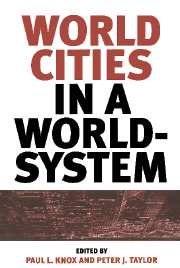Book contents
- Frontmatter
- Contents
- List of contributors
- Preface
- Part 1 Introduction: world city, hypothesis and context
- Part 2 Cities in systems
- 5 Cities in global matrices: toward mapping the world-system's city system
- 6 World cities, multinational corporations, and urban hierarchy: the case of the United States
- 7 Transport and the world city paradigm
- 8 The world city hypothesis: reflections from the periphery
- 9 Global logics in the Caribbean city system: the case of Miami
- 10 Comparing Chicago, New York, and Los Angeles: testing some world cities hypotheses
- 11 ‘Going global’ in the semi-periphery: world cities as political projects. The case of Toronto
- Part 3 Politics and policy in world cities: theory and practice
- Appendix The world city hypothesis
- Index
9 - Global logics in the Caribbean city system: the case of Miami
Published online by Cambridge University Press: 07 October 2009
- Frontmatter
- Contents
- List of contributors
- Preface
- Part 1 Introduction: world city, hypothesis and context
- Part 2 Cities in systems
- 5 Cities in global matrices: toward mapping the world-system's city system
- 6 World cities, multinational corporations, and urban hierarchy: the case of the United States
- 7 Transport and the world city paradigm
- 8 The world city hypothesis: reflections from the periphery
- 9 Global logics in the Caribbean city system: the case of Miami
- 10 Comparing Chicago, New York, and Los Angeles: testing some world cities hypotheses
- 11 ‘Going global’ in the semi-periphery: world cities as political projects. The case of Toronto
- Part 3 Politics and policy in world cities: theory and practice
- Appendix The world city hypothesis
- Index
Summary
Studies of urbanization processes in the Caribbean in the past two decades tend either (1) to consider urbanization processes in the Caribbean outside of a global context (e.g. Hope 1986), or (2) to consider the local urban dynamics of urbanization apart from the Caribbean city system (e.g. Cross 1979; Portes and Lungo 1992; Potter 1989). The limitations of the studies that examine Caribbean urbanization are also to be seen in the literature on Miami. This literature tends to analyse Miami in relation to the Caribbean and Latin America in terms of the Cuban presence, but does not consider it as a world city (e.g. Allman 1987; Didion 1987; Garreau 1981; Grenier and Stepick 1992; Mohl 1983; Porter and Dunn 1984; Portes and Stepick 1993).
The Caribbean city system refers to a regional division of labour that produces transnational linkages between the most important Caribbean cities; this regional division of labour is based on the movement of commodities, capital, and people across cities. A movement which challenges traditional boundaries. This movement produces a hierarchical division of labour among the region's cities in terms of three distinctive roles: core, semi-periphery, and periphery.
The purpose of this chapter is to analyse the historical—structural developments that explain the emergence of Miami as a world city within the Caribbean city system during the 1970s and 1980s.
- Type
- Chapter
- Information
- World Cities in a World-System , pp. 156 - 170Publisher: Cambridge University PressPrint publication year: 1995
- 35
- Cited by

